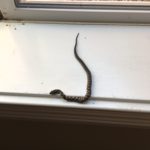 Purdue University - Extension - Forestry and Natural Resources
Purdue University - Extension - Forestry and Natural Resources
Got Nature? Blog
Wild animals have a dispersal period where young move on to new ground to establish their own home range. This is nature’s way of mixing the gene pool. It also allows for species to reoccupy small, isolated habitat patches. Late summer and early fall is a common time to see juvenile snakes because of dispersal.
Snake identification questions are one of my most common that I receive from the public. Usually, people want to know if the snake is venomous or not. Most snakes in Indiana are not venomous. In fact, there are only four venomous species in Indiana. Their distributions are generally limited.
The snake pictured here to the right is a Northern Watersnake (Nerodia sipedon). Photo and identification request was submitted to our “Ask an Expert” web submission by Mr. R. Dearing. While only about a foot long here, adults can reach several feet in length. Coloration in them is variable, but they typically have dark bands on a lighter tan or brown background. The bands are complete towards the head and fragment towards the tail. This little snake found its way into Mr. Dearing’s house. Fortunately, he was able to catch it and return it to the creek behind their house—which explains why it was there in the first place.
Resources:
Snakes and Lizards of Indiana, The Education Store, Purdue Extension
How can I tell if a snake is venomous, FAQs, Purdue Extension-Forestry and Natural Resources
Indiana Amphibian and Reptile ID Package, The Education Store, Purdue Extension
Ask An Expert, Purdue Extension-Forestry and Natural Resources
Brian MacGowan, Extension Wildlife Specialist
Department of Forestry & Natural Resources, Purdue University

Recent Posts
- Farmers Helping Hellbenders RCPP Program Accepting Applications
Posted: May 1, 2024 in Aquaculture/Fish, Forestry, How To, Wildlife, Woodlands - Extension Specialist Brian MacGowan Receives Hoosier Wildlife Award
Posted: in Forestry, Wildlife - MyDNR – First positive case of chronic wasting disease in Indiana
Posted: April 29, 2024 in Alert, Disease, How To, Safety, Wildlife - Publication – Introduction to White-tailed Deer Impacts on Indiana Woodlands
Posted: April 28, 2024 in Forestry, Land Use, Plants, Publication, Wildlife, Woodlands - Publication – Understanding White-tailed Deer and Their Impact on Indiana Woodlands
Posted: in Forestry, Land Use, Plants, Publication, Wildlife, Woodlands - Publication – Monitoring White-tailed Deer and Their Impact on Indiana Woodlands
Posted: in Forestry, Land Use, Plants, Publication, Wildlife, Woodlands - Publication – Managing White-tailed Deer Impacts on Indiana Woodlands
Posted: in Forestry, Land Use, Plants, Publication, Wildlife, Woodlands - Report Spotted Lanternfly – Purdue Landscape Report
Posted: April 10, 2024 in Alert, Forestry, Invasive Insects, Plants, Wildlife, Woodlands - Declining Pines of the White Variety – Purdue Landscape Report
Posted: in Alert, Disease, Forestry, Plants, Wildlife, Woodlands - Are you seeing nests of our state endangered swan? – Wild Bulletin
Posted: April 9, 2024 in Alert, Forestry, How To, Wildlife
Archives
Categories
- Alert
- Aquaculture/Fish
- Aquatic/Aquaculture Resources
- Ask the Expert
- Christmas Trees
- Community Development
- Disease
- Drought
- Forestry
- Forests and Street Trees
- Gardening
- Got Nature for Kids
- Great Lakes
- How To
- Invasive Animal Species
- Invasive Insects
- Invasive Plant Species
- Land Use
- Natural Resource Planning
- Nature of Teaching
- Plants
- Podcasts
- Ponds
- Publication
- Safety
- Timber Marketing
- Uncategorized
- Urban Forestry
- Webinar
- Wildlife
- Wood Products/Manufacturing
- Woodland Management Moment
- Woodlands
